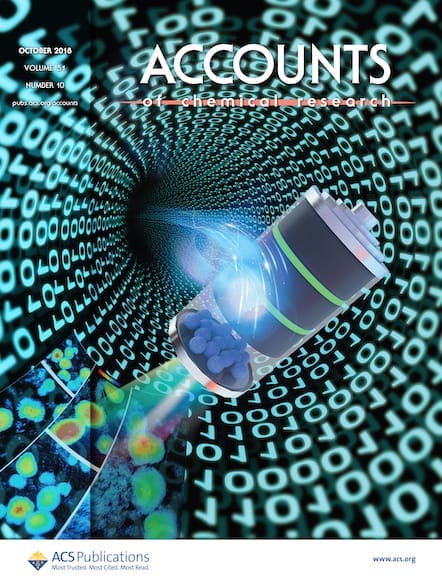Jin-Quan Yu, a professor at the Scripps Research Institute, is a recipient of a 2016 MacArthur Foundation grant for his work in developing new ways to break carbon-hydrogen bonds. He’s also the author of 99 papers in ACS Publications journals including ACS Catalysis, ACS Central Science, Accounts of Chemical Research, Journal of the American Chemical […]

Jin-Quan Yu, a professor at the Scripps Research Institute, is a recipient of a 2016 MacArthur Foundation grant for his work in developing new ways to break carbon-hydrogen bonds. He’s also the author of 99 papers in ACS Publications journals including ACS Catalysis, ACS Central Science, Accounts of Chemical Research, Journal of the American Chemical Society, The Journal of Organic Chemistry, Organometallics, and Organic Letters. ACS Axial reached out to Yu to learn more about his research, his approach to overcoming setbacks, and his plans for the future.
How would you describe your research?
The central theme of our research is to develop C-H activation reactions that are not in the textbook yet. We hope to use these reactions to shorten the synthesis of molecules that can benefit humankind, especially drug molecules. The choice of a particular project is usually driven by a combination of curiosity and a desire to solve a synthetic problem.
For example, we were initially enticed to figure out how a metal can insert into C-H bonds asymmetrically. Subsequently, we moved on to develop novel asymmetric C-H activation reactions of broadly useful substrates to make chiral molecules in a completely new way.
How did you first become interested in finding ways to break carbon-hydrogen bonds?
Fundamentally, my mind was somehow always attracted to making molecules. I studied how enzymes make molecules during my Ph.D, then how organic chemists make molecules during my postdoctoral studies. My postdoctoral training with E. J. Corey really got me to realize that replacing C-H bonds with carbon-carbon, carbon-nitrogen, and carbon-oxygen bonds will be transformative. Especially asymmetric C-H activation reactions will provide new ways to make chiral molecules.
Were there any special challenges involved in this work?
The first big challenge is that those substrates commonly used by synthetic chemists are generally not compatible with C-H activation reactions. This is a tremendous psychological barrier to overcome and took us a good 10 years to really establish that those weakly coordinating substrates used in organic synthesis are actually compatible under the right conditions, especially with help from ligand acceleration.
Second, there is little understanding of how to control the stereochemistry of metal insertion into C-H bonds, which prevented us from developing chiral ligands to achieve asymmetric C-H activation reactions. In essence, a majority of C-H insertion reactions are simply driven by substrates. These reactions simply give background reactions without external ligand influence ,which make it very difficult to achieve ligand-controlled asymmetric C-H activation reactions. We have finally made a big stride only until this year.
During the 14 years you spent working on this topic, did you ever feel frustrated? How did you overcome setbacks in the lab?
Failure and frustration are an intimate part of research. It is crucial to analyze the negative result and try to extract useful information that will take you forward, even if it is a tiny step. In developing new reactions, it often takes many small steps to eventually reach the boiling point.
How would you like to see your work used? What would like your legacy to be?
The most direct applications are for drug discovery at the early stage. I am very pleased to see many uses in this context in the pharmaceutical industry, especially in generating privileged chiral building blocks and fragments. I am equally keen to see applications of our reactions in large-scale production. At least two reactions (C-H iodination and arylation) have been currently selected as a competitive route for potential kilo-scale preparation of drug molecules. In the long run, I hope some of the best C-H activation reactions from many laboratories around the world will appear in textbooks, making contributions to education.
What advice do you regularly share with your students?
We discuss regularly how to spot an interesting problem worth spending your most precious time on. We ask two questions: Would this teach us something new? Will synthetic chemists use this reaction frequently if developed?
How do you expect the MacArthur grant award will change your life and work?
It is a truly humbling experience to receive such a surprising phone call. I will be more willing to take a risk and focus on solving some of the most challenging and important problems in the area of C-H activation.
What are you working on next?
We will develop a wide range of asymmetric C-H activation of bulky chemicals containing one or two functional groups. Some of these reactions will mimic enzymatic transformations using small catalysts. We have had some initial success in activating C-H bonds that are distal to functional groups, but this direction has a long way to go. We need to develop more strategies and catalysts to accommodate longer distance and more substrates. As a complementary approach, we will continue to develop non-directed C-H activation reactions where the selectivity will be controlled by the steric and electronic environment of substrates.
Learn more about Jin-Quan Yu’s research in ACS Publications.
Want the latest stories delivered to your inbox each month?

Accounts of Chemical Research
Read our latest issue. Want to contribute to this journal?